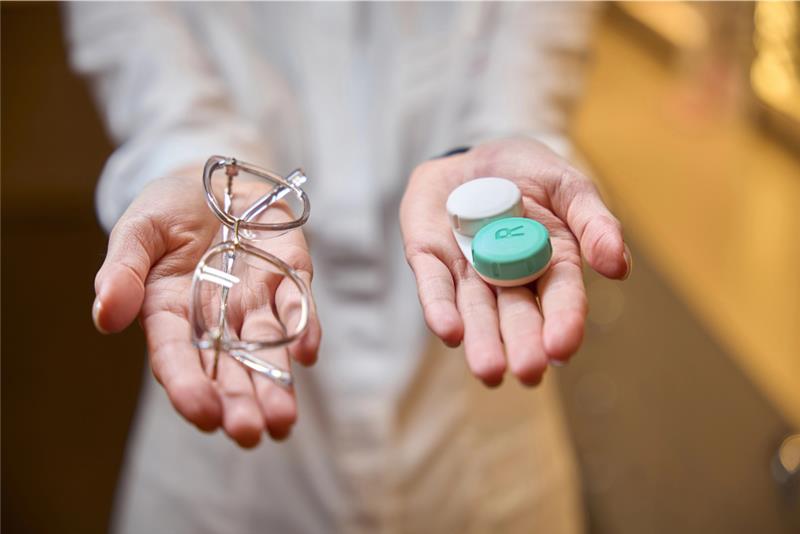A common concern for many, a pterygium is a non-cancerous growth that appears on the surface of the eye. Often wedge-shaped, it typically starts on the white part of the eye and can, over time, extend towards the cornea, the clear, central part of your eye. While not cancerous, a pterygium can be a source of irritation and, if left unaddressed, may impact vision. Common culprits behind its development include prolonged exposure to sun, wind, dust, and dry environments.
One of the most frequent questions an eye doctor in Beverly Hills hears from patients with this condition is: “Can I still wear contact lenses if I have a pterygium?” This blog post aims to answer that important question, delving into the potential risks, available options, and suitable alternatives for managing contact lens wear with a pterygium.
Understanding Pterygium and How It Affects the Eye
A pterygium typically originates on the conjunctiva (the white part of the eye) and can gradually advance towards the cornea. In its early stages, it might be asymptomatic, but as it progresses, individuals often experience symptoms such as redness, a persistent feeling of something in the eye (foreign body sensation), and general irritation. If the growth extends far enough to cover the pupil or distort the cornea, it can even lead to blurred vision.
The presence of a pterygium can subtly, or sometimes significantly, alter the natural curvature and smoothness of the eye’s surface. This alteration is precisely why wearing contact lenses with eye growth can become more complicated. A raised or uneven surface can interfere with the proper fit and movement of a contact lens, leading to discomfort, blurry vision, and even exacerbate the irritation associated with the pterygium itself.
Can You Wear Contacts With a Pterygium?
The short answer is: it depends on the severity and size of the pterygium.
In early and mild cases, many patients can indeed continue wearing contact lenses, often with some adjustments to their lens type or wearing habits. The key here is regular monitoring by a qualified Beverly Hills ophthalmologist.
However, as the pterygium grows and becomes more prominent, contact lens wear can become increasingly challenging. In moderate to advanced cases, lenses may cause significant discomfort, move irregularly on the eye, or worsen the existing irritation. This is where understanding your options and working closely with your eye care professional becomes paramount. The importance of a proper contact lens fitting and regular eye exams cannot be overstated when dealing with a pterygium.
Factors That Affect Contact Lens Tolerance
Several factors play an important role in determining whether you can comfortably and safely continue wearing contact lenses with a pterygium:
- Location and Thickness of the Pterygium: A pterygium located closer to the center of the cornea or one that is particularly thick will have a greater impact on lens fit and comfort.
- Presence of Dry Eye or Irritation: Pterygium can often be accompanied by dry eye symptoms, and the combination of both can make contact lens wear significantly less tolerable.
- Type of Contact Lenses Used: Different lens materials and designs interact with the eye surface in unique ways.
- Lens Hygiene and Daily Wear Time: Poor lens hygiene and extended wear can lead to increased irritation and the potential for complications.
Also Read: Pterygium Removal: When Surgery Becomes Necessary
Best Contact Lens Options for Patients With Pterygium
When considering can I wear contacts with pterygium, the type of lens you choose makes a significant difference:
- Soft Lenses: These are generally comfortable in the early stages of a pterygium due to their flexibility. However, they can sometimes dry out or become irritating if the pterygium is raised, as the lens may rub against the growth.
- Rigid Gas Permeable (RGP) Lenses: While offering excellent vision due to their ability to correct corneal irregularities, RGP lenses are generally less comfortable than soft lenses, especially if the pterygium is significantly raised, as they are smaller and rest more directly on the corneal surface.
- Scleral Lenses: These are often the preferred choice in more advanced cases of pterygium or when other lens types prove intolerable. Scleral lenses have a larger diameter, extending beyond the cornea and vaulting over the entire corneal surface, including the pterygium. This design allows them to rest on the sclera (the white of the eye), effectively creating a tear-filled reservoir between the lens and the cornea, which can provide exceptional comfort and vision, even with a prominent pterygium.
Custom lens fittings by an experienced optometrist or corneal specialist are highly recommended to ensure the best possible fit and comfort for patients dealing with contact lens irritation from pterygium.
Managing Discomfort and Protecting Your Eyes
Regardless of whether you wear contact lenses, managing the symptoms of a pterygium is important for comfort and preventing progression. Here are some strategies:
- Using lubricating eye drops: These can help reduce dryness and friction between the lens (or eyelid) and the pterygium.
- Avoiding contact lens overwear: Give your eyes a break to reduce irritation.
- Wearing UV-protective sunglasses: This is vital for preventing pterygium progression, as UV exposure is a primary cause. Look for sunglasses that block 99-100% of both UVA and UVB rays.
- Taking breaks from contact lenses: If your eye feels irritated, remove your lenses and allow your eyes to rest.
- Discussing anti-inflammatory treatments or eyedrops with your doctor: Your ophthalmologist may prescribe medication to reduce redness and inflammation.
For those in the Beverly Hills area seeking the best ophthalmologist for pterygium in Beverly Hills, it’s important to find a specialist who can guide you through these management strategies and recommend the most appropriate course of action.
Also Read: Does Pterygium Affect Your Vision? Here’s When to See an Eye Doctor
When to Consider Surgery
While many pterygium cases can be managed conservatively, there are instances where surgery becomes necessary. Your Beverly Hills ophthalmologist may recommend pterygium treatment near me in the following situations:
- If the pterygium grows towards the center of the cornea and begins to affect your vision.
- If it causes constant irritation, redness, or foreign body sensation that significantly interferes with your daily life or contact lens use.
- If it is cosmetically bothersome.
Pterygium removal surgery is a common procedure, often performed on an outpatient basis. Post-operative care is important, and your doctor will advise you on when it is safe to resume contact lens wear. Many patients find that after successful surgery and proper healing, they can return to contact lens wear with significantly better comfort and vision.
Conclusion
The answer to “Can I wear contacts with pterygium?” is not a simple yes or no. It fundamentally depends on the severity of your condition, the type of contact lenses you use, and your overall eye health. The good news is that with proper care and the right approach, safe contact use with pterygium is often possible.
The most important step is to work closely with an experienced eye care provider, especially a pterygium in Beverly Hills specialist, who understands the unique challenges posed by this condition. They can accurately assess your eye, customize your contact lens options, and guide you through managing the condition to preserve your comfort and vision. By addressing the condition early and seeking expert advice, you can often continue enjoying the benefits of contact lens wear while effectively managing your pterygium.
Ready to discuss your contact lens options with a pterygium? Visit Soroudi Advanced Lasik & Eye Centers today to schedule a comprehensive eye exam.



